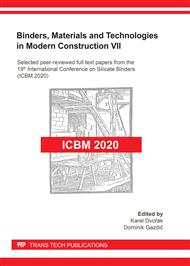p.119
p.125
p.131
p.137
p.143
p.150
p.156
p.162
p.168
Influence of Nitrate Species ANO3 and ANO3·nH2O on Physico-Mechanical Properties of the Aluminosilicate Adhesives for Wood and Wooden Structures
Abstract:
The article presents the results of studies of the effect of lithium, sodium, potassium and ammonium nitrates on the physical and mechanical properties of aluminosilicate adhesives intended for gluing wood and structures based on them. Nitrates were introduced into the aluminosilicate adhesive of composition Na2O·Al2O3·6SiO2·20H2O in amounts of 0.5, 1 and 1.5 wt. %. Changes in the shear strength along the fibers of substrates made of pine, beech, and oak wood were studied after 7 and 28 days of hardening of aluminosilicate adhesives in vivo. It is shown that for gluing pine wood it is most expedient to use adhesives containing lithium nitrate, potassium nitrate and ammonium nitrate is within 1.5 wt. %, the shearing strength along the fibers after 28 days of hardening is 1.7-1.8 times higher than the strength of the adhesive without additives. For gluing beech wood, it is most advisable to use adhesives containing potassium and ammonium nitrate in an amount of 1.5 wt. %, the shearing strength along the fibers after 28 days of hardening is 1.5 times lower than the strength of the adhesive without additives. For gluing oak wood, it is most advisable to use adhesives containing lithium nitrate, potassium nitrate and ammonium nitrate in amounts of 0.5 and 1.5 wt. %, the shear strength along the fibers increases by 1.3-1.5 times for 7 and 28 days of hardening compared to the strength of the adhesive without additives. According to the degree of influence on strength, modifying additives can be ranked in the series LiNO3×3H2O>KNO3>NH4NO3>NaNO3.
Info:
Periodical:
Pages:
143-149
Citation:
Online since:
October 2021
Price:
Сopyright:
© 2021 Trans Tech Publications Ltd. All Rights Reserved
Share:
Citation:


